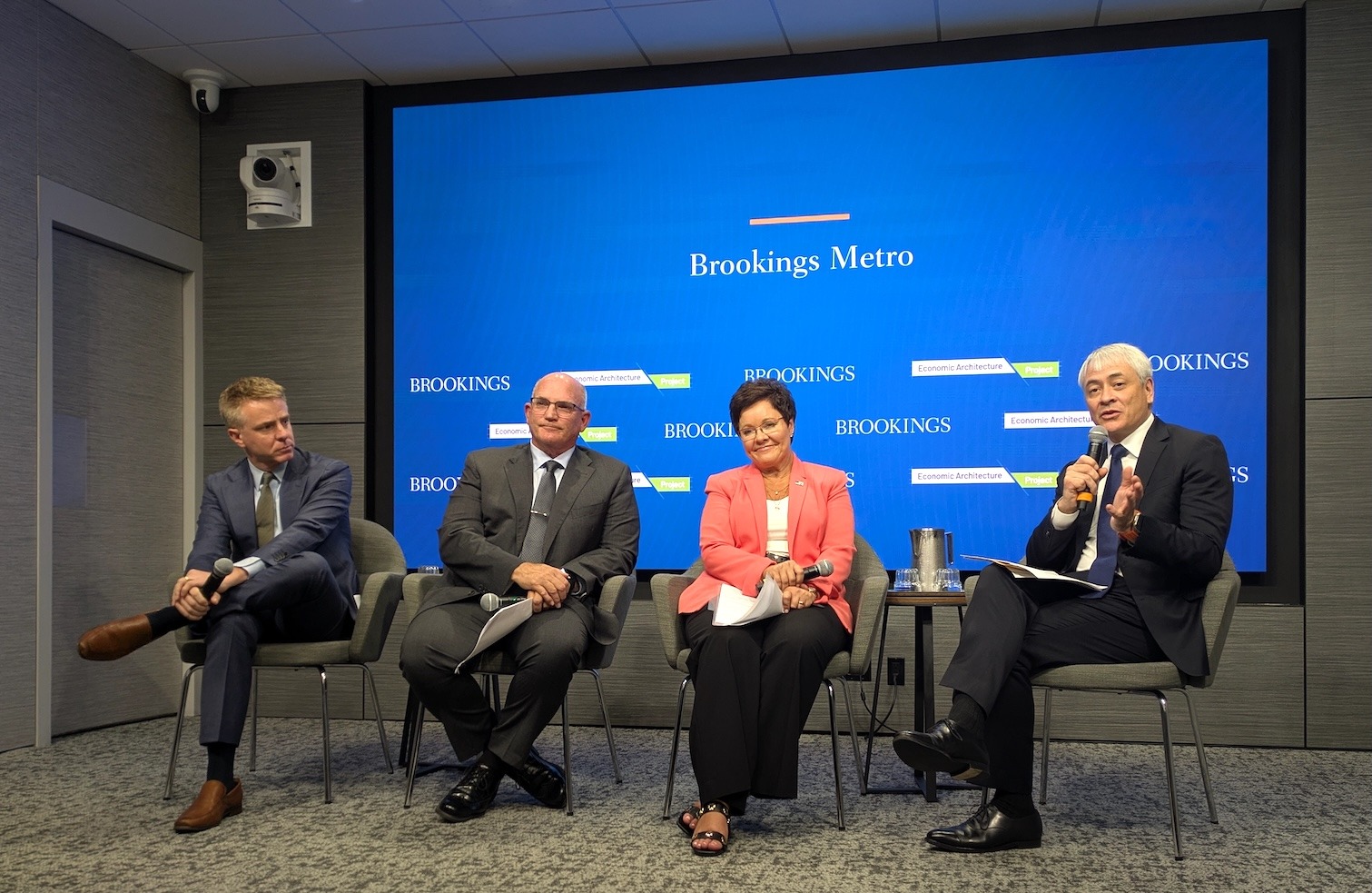On July 29, Brookings Metro and Economic Architecture hosted the second event in the Safe, Healthy, and Resilient Homes series. The in-person discussion, focused on “Wildfire Resilience,” took place at the Brookings Institution in Washington, D.C., and featured experts and innovators working to create stronger, safer, and healthier communities in the face of ever-present wildfire threats and their aftermath.
The event featured:
- Manann Donoghoe, Fellow, The Brookings Institution
- Peter Ambler, Vice President, Global Government Affairs, Pano AI
- Chief Frank Frievalt, Director of the WUI Fire Institute, Cal Poly, San Luis Obispo
- Lori Moore-Merrell, Former U.S. Fire Administrator
- Andre Perry, Senior Fellow, The Brookings Institution
- Stuart Yasgur, Founder and Principal, Economic Architecture
Watch the full video of the event:
Community level innovations for wildfire resilience
“When wildfires tear through a neighborhood, they don’t just consume homes and landscapes,” Andre Perry emphasized. “They consume dreams, generational wealth, and the very foundations of community progress we’ve worked so hard to build.”
“Wildfire resilience isn’t just about surviving the next fire. It’s about community-level security that requires us to think structurally, addressing vulnerabilities before disaster strikes and building back stronger when it does,” he added.
Understanding the need for structural change for safer future
Stuart Yasgur, Founder and Principal, Economic Architecture, offered that, although wildfires have escalated in recent years, fire plays a natural part of maintaining a healthy ecosystem, and to some extent, fires are here to stay.
Therefore, Yasgur said, “We need to ask how we reduce the risk that wildfires pose to people, communities and property. How do we become more resilient?”
“To reduce risk, we need to influence an enormous number of individual and collective decisions,” Yasgur added. “And if we’re going to do this at a large scale, at a scale that rises to the magnitude of the problem, that’s going to require structural change, structural change that uses a broad range of different tools, from policy and planning to regulation, technology, and market-based innovations.”
Brookings Metro Fellow Manann Donoghoe set the stage by describing current risks posed by wildfires. “In 2024, for example, there were a total of 64,897 wildfires that burned close to a combined nine million acres. That’s about three times more than the annual average between the 1980s and 2000s.”
Donoghoe emphasized that the number of fires started by lightning or arson has gone down. The problem is that the fires that do begin are more intense, and the number of people and homes in their pathways has risen. Donoghue also emphasized that fire is not just a physical problem but one with policy- and market-based causes and potential for intervention.
Yasgur turned to the panel to understand how markets and policy are innovating solutions.
Prevention and mitigation strengthen wildfire resilience
Former U.S. Fire Administrator Lori Moore-Merrell explained that prevention is everything. In cases like January’s devastating Los Angeles fires, for instance, firefighters could do little to control the fire once it involved multiple structures. “When you have an ignition and fuel load like we saw in L.A., we’re off to the races… We must change our built environment and the materials with which we build.”
Chief Frank Frievalt also emphasized the importance of prevention and mitigation, and focused on the importance of fuel mitigation in areas called Wildland Urban Interface, or “WUIs,” zones between uninhabited natural lands and land developed and inhabited by humans. These places rely on fire as a part of their ecosystems, and deforestation, combined with building structures that can ignite and spread embers, have created dangerous conditions for extreme wildfires. These structures become fuel for fires. Better building codes and regular, controlled burns are critical to reducing extreme wildfires in WUI zones.
“We need to retrofit and mitigate the existing system of fuels that we call home,” said Frievalt. Frievalt and Moore-Merrell agreed that fuel mitigation and widespread adoption of and enforcement of building codes, like the IBHS building standards are critical to more wildfire-resilient communities.
Technology expands innovations for wildfire resilience
Vice President of Global Government Affairs for Pano AI, Peter Ambler, discussed the role that new technologies are playing in mitigation. Pano AI has developed technology for early fire detection and automated reporting of its precise location, shortening the time between the beginning of a fire and firefighters’ ability to respond.
In addition to developing and adopting these new technologies, Ambler said, “We also need to organize to demand greater preparation well in advance of the next wildfire to impact our communities.”
“We cannot wait until smoke is hanging thickly in the air. We cannot wait until we can literally see the flames from our homes. We need Americans of all stripes to organize,” Ambler said.
Looking ahead on community, policy and structural innovation
Andre Perry closed the session by pointing to the centrality of the concept of “fuel” in the conversation, as both cause of and means of preventing extreme fires. “Perhaps,” he suggested, “We can also become the fuel that builds instead of burns.”
